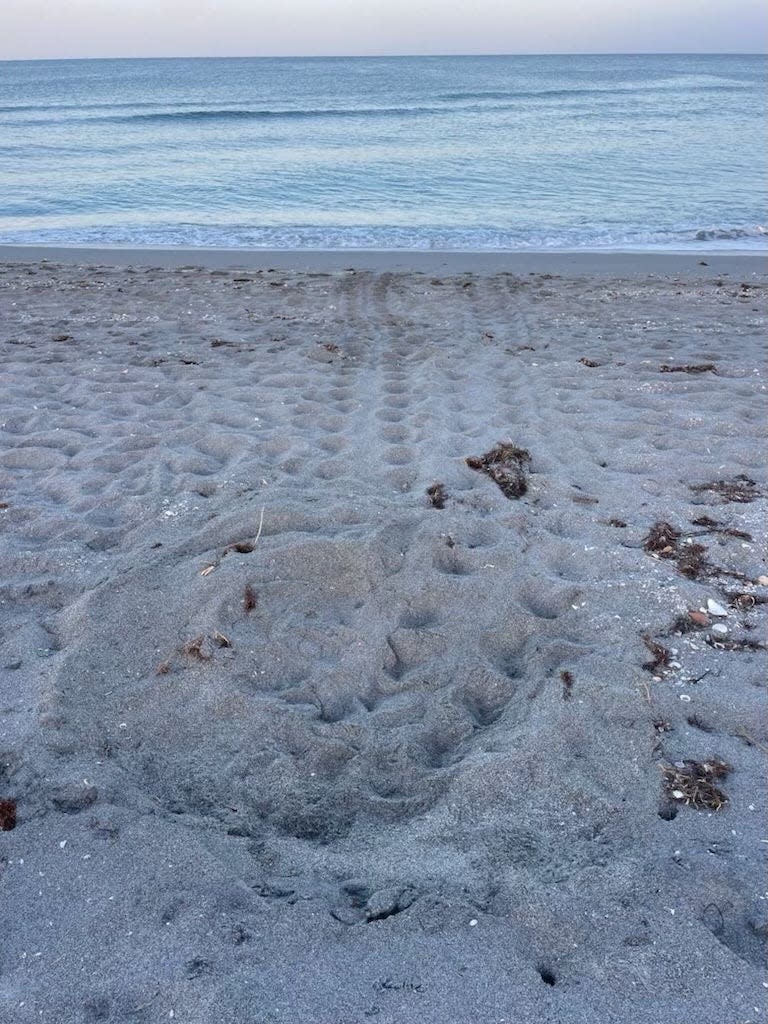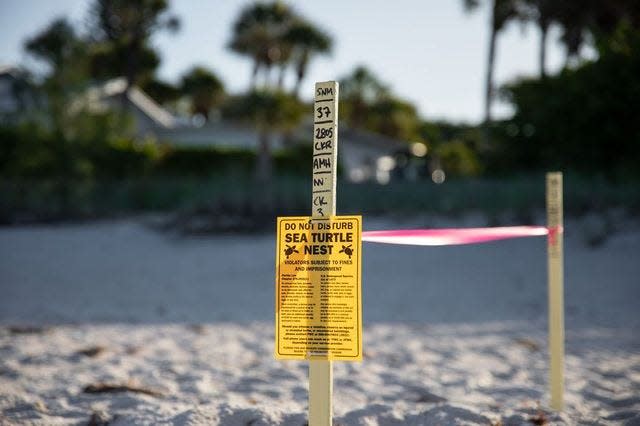First sea turtle nest of season in Sarasota County found on Venice Beach

Mote Marine Laboratory’s Sea Turtle Conservation and Research Program (STCRP) documented the first local sea turtle nest of the 2024 season on Sunday, April 28, on Venice Beach, marking the beginning of a crucial period for sea turtle conservation, according to a news release.
The first nest was laid by a loggerhead sea turtle, a threatened species protected under federal law, the release from Mote noted. Loggerheads are the most common species on southwest Florida nesting beaches, followed by endangered green sea turtles. In recent years, Sarasota County has also hosted a handful of endangered Kemp’s ridleys, among the smallest and rarest sea turtles.
During nesting season, the STCRP documents nesting activities, which allows them to analyze trends, shifts in timing of nesting events in relation to the seasons, nesting density, the number of eggs in a nest that produces live hatchlings that surface, environmental impacts, effects of nest site selection and more.
Each nest is marked with yellow stakes and flagging tape.
More: Mote Marine reaches key milestone for aquarium project with placement of windows
From April 15 to Oct. 31, the organization's Sea Turtle Patrol conducts daily monitoring during the nesting season. Each day, they volunteers survey 35 miles of beaches, from Longboat Key to Venice, for the nests.
“Even though sea turtle nesting season isn’t officially supposed to start until May 1, we like to be prepared and patrol early to make sure we catch the first signs of nesting on our beaches,” said Melissa Macksey, Senior Biologist and Conservation Manager of STCRP. “Our enthusiastic volunteers and interns make patrolling 35 miles of beaches possible. We could not do it without them. They are the reason we were able to catch this early nest.”
The effort involves Mote staff, interns and more than 300 volunteers. Monitoring began April 15. This marks the 43rd for the monitoring program.

Mote’s research shows that nest numbers have increased on local beaches in recent years. In 2023, Mote reported 4,284 nests from Longboat Key to Venice.
The public can view Mote’s weekly counts of sea turtle nests within the patrol area at www.mote.org/2024nesting.
“Now that we have identified the first nest of the season, we implore beachgoers to be conscious of the sea turtles while enjoying Florida’s unparalleled beaches,” said Macksey. “There are many simple ways to help protect sea turtles and their nests. Hatchlings will have a better chance at surviving if everyone does their part.”
On the nesting beaches, light from waterfront properties can disorient nesting female turtles and their young, who emerge at night and use dim natural light to find the sea. Beach furniture, trash, and other obstacles can also impede sea turtles and their young.
Mote advises people to shield or turn off outdoor lights that are visible on the beach from May through October.
Close drapes after dark and stack beach furniture at the dune line or, ideally, remove it from the beach.
If you encounter a nesting turtle or hatchlings, remain quiet and observe from a distance.
Fill in holes that may entrap hatchlings on their way to the water.
Do note approach nesting turtles or hatchlings, make noise, or shine lights at turtles, and do not use flashlights or fishing lamps on the beach.
Also, do not encourage a turtle to move while nesting or pick up hatchlings that have emerged and are heading for the water.
For more details, refer to local sea turtle ordinances, including Sarasota County’s marine turtle protection code (which includes Lido, Siesta, Casey, and Manasota Keys), the city of Venice marine turtle protection ordinance, and the Town of Longboat Key marine turtle protection ordinance. For questions about any sea turtle code or ordinance, contact code enforcement staff from each municipality.
If you see a sick, injured, or stranded sea turtle, dolphin, or whale in Sarasota or Manatee county waters, contact Mote Marine Laboratory’s Stranding Investigations Program at 888-345-2335. Outside of Sarasota or Manatee counties, please call the Florida Fish and Wildlife Conservation Commission (FWC) at 888-404-FWCC (3922).
If you suspect that someone is tampering with a sea turtle nest, harassing a sea turtle, or has possession of a sea turtle or any of its parts, please call FWC or your local sheriff’s department.
Sea turtles are protected under federal law and any harassment or interference with a sea turtle, living or dead, their eggs and/or nest marking materials is subject to penalty.
This article originally appeared on Sarasota Herald-Tribune: First sea turtle nest of 2024 season found on Venice Beach

